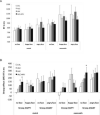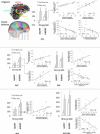White matter fiber compromise contributes differentially to attention and emotion processing impairment in alcoholism, HIV-infection, and their comorbidity
- PMID: 22960416
- PMCID: PMC3473169
- DOI: 10.1016/j.neuropsychologia.2012.07.042
White matter fiber compromise contributes differentially to attention and emotion processing impairment in alcoholism, HIV-infection, and their comorbidity
Abstract
Alcoholism (ALC) and HIV-1 infection (HIV) each affects emotional and attentional processes and integrity of brain white matter fibers likely contributing to functional compromise. The highly prevalent ALC+HIV comorbidity may exacerbate compromise. We used diffusion tensor imaging (DTI) and an emotional Stroop Match-to-Sample task in 19 ALC, 16 HIV, 15 ALC+HIV, and 15 control participants to investigate whether disruption of fiber system integrity accounts for compromised attentional and emotional processing. The task required matching a cue color to that of an emotional word with faces appearing between the color cue and the Stroop word in half of the trials. Nonmatched cue-word color pairs assessed selective attention, and face-word pairs assessed emotion. Relative to controls, DTI-based fiber tracking revealed lower inferior longitudinal fasciculus (ilf) integrity in HIV and ALC+HIV and lower uncinate fasciculus (uf) integrity in all three patient groups. Controls exhibited Stroop effects to positive face-word emotion, and greater interference was related to greater callosal, cingulum and ilf integrity. By contrast, HIV showed greater interference from negative Stroop words during color-nonmatch trials, correlating with greater uf compromise. For face trials, ALC and ALC+HIV showed greater Stroop-word interference, correlating with lower cingulate and callosal integrity. Thus, in HIV, conflict resolution was diminished when challenging conditions usurped resources needed to manage interference from negative emotion and to disengage attention from wrongly cued colors (nonmatch). In ALC and ALC+HIV, poorer callosal integrity was related to enhanced emotional interference suggesting curtailed interhemispheric exchange needed between preferentially right-hemispheric emotion and left-hemispheric Stroop-word functions.
Copyright © 2012 Elsevier Ltd. All rights reserved.
Figures



Similar articles
-
Disruption of emotion and conflict processing in HIV infection with and without alcoholism comorbidity.J Int Neuropsychol Soc. 2011 May;17(3):537-50. doi: 10.1017/S1355617711000348. J Int Neuropsychol Soc. 2011. PMID: 21418720 Free PMC article.
-
Callosal Compromise Differentially Affects Conflict Processing and Attentional Allocation in Alcoholism, HIV, and Their Comorbidity.Brain Imaging Behav. 2008;2(1):27-38. doi: 10.1007/s11682-007-9014-z. Brain Imaging Behav. 2008. PMID: 19360136 Free PMC article.
-
Callosal degradation in HIV-1 infection predicts hierarchical perception: a DTI study.Neuropsychologia. 2010 Mar;48(4):1133-43. doi: 10.1016/j.neuropsychologia.2009.12.015. Epub 2009 Dec 16. Neuropsychologia. 2010. PMID: 20018201 Free PMC article.
-
White matter connectivity in bipolar disorder.Int Rev Psychiatry. 2009;21(4):380-6. doi: 10.1080/09540260902962172. Int Rev Psychiatry. 2009. PMID: 20374151 Review.
-
Cerebral white matter integrity and cognitive aging: contributions from diffusion tensor imaging.Neuropsychol Rev. 2009 Dec;19(4):415-35. doi: 10.1007/s11065-009-9113-2. Epub 2009 Aug 25. Neuropsychol Rev. 2009. PMID: 19705281 Free PMC article. Review.
Cited by
-
The Abnormality of Topological Asymmetry in Hemispheric Brain Anatomical Networks in Bipolar Disorder.Front Neurosci. 2018 Sep 3;12:618. doi: 10.3389/fnins.2018.00618. eCollection 2018. Front Neurosci. 2018. PMID: 30233301 Free PMC article.
-
Neuroimaging and Cognitive Evidence for Combined HIV-Alcohol Effects on the Central Nervous System: A Review.Alcohol Clin Exp Res. 2021 Feb;45(2):290-306. doi: 10.1111/acer.14530. Epub 2020 Dec 30. Alcohol Clin Exp Res. 2021. PMID: 33296091 Free PMC article.
-
Heritability of the limbic networks.Soc Cogn Affect Neurosci. 2016 May;11(5):746-57. doi: 10.1093/scan/nsv156. Epub 2015 Dec 28. Soc Cogn Affect Neurosci. 2016. PMID: 26714573 Free PMC article.
-
Profiles of impaired, spared, and recovered neuropsychologic processes in alcoholism.Handb Clin Neurol. 2014;125:183-210. doi: 10.1016/B978-0-444-62619-6.00012-4. Handb Clin Neurol. 2014. PMID: 25307576 Free PMC article. Review.
-
Differential impairments across attentional networks in binge drinking.Psychopharmacology (Berl). 2017 Apr;234(7):1059-1068. doi: 10.1007/s00213-017-4538-4. Epub 2017 Jan 31. Psychopharmacology (Berl). 2017. PMID: 28144707
References
-
- American Psychiatric Association . Diagnostic and Statistical Manual of Mental Disorders. 4th Edition. American Psychiatric Press Inc.; Washington, DC: 2000. Text Revision (DSM-IV-TR)
-
- Ances BM, Roc AC, Wang J, Korczykowski M, Okawa J, Stern J, Kim J, Wolf R, Lawler K, Kolson DL, Detre JA. Caudate blood flow and volume are reduced in HIV+ neurocognitively impaired patients. Neurology. 2006;66:862–866. - PubMed
-
- Bagasra O, Pomerantz RJ. Human immunodeficiency virus type 1 replication in peripheral blood mononuclear cells in the presence of cocaine. The Journal of Infectious Diseases. 1993;168:1157–1164. - PubMed
Publication types
MeSH terms
Grants and funding
LinkOut - more resources
Full Text Sources
Medical

